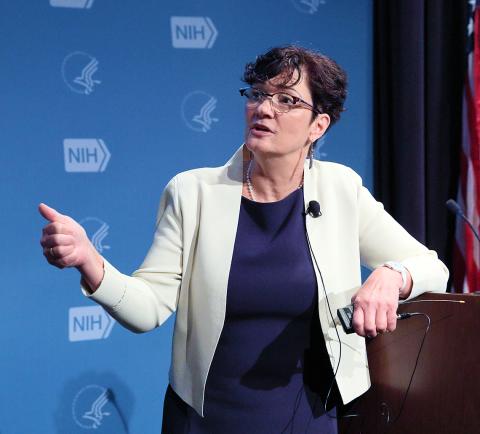Military a ‘Perfect Lab’ for Studying Pain, Larson Says

Photo: Chia-Chi Charlie Chang
As surprising as it may be, given the size and complexity of the system, health care in the U.S. military has been a true innovator over the past decade in caring for chronic pain and the health problems often associated with it—such as trauma, mood disorders, substance use disorders and sleep problems.
So says Dr. Mary Jo Larson, a senior scientist at Brandeis University’s Institute for Behavioral Health and an NCCIH grantee, who lectured recently in Lipsett Amphitheater as part of NCCIH’s Integrative Medicine Research Lecture Series. Her focus was nondrug therapies for chronic pain in the Military Health System, which is part of the Department of Defense and delivers health care to 9.4 million beneficiaries worldwide.
Larson described a watershed moment in 2010 when the report of the Army pain management task force was released. The group was chartered by the Army surgeon general to make recommendations for a comprehensive pain-management strategy that would be “holistic, multidisciplinary and multimodal in its approach, utilize state-of-the-art/science modalities and technologies and provide optimal quality of life for soldiers and other patients with acute and chronic pain.” It would seek to address problems of deficiencies and unwarranted variability in pain care across DoD, as well as concerns with medication abuse and rising suicide rates that often appeared pain-related. The resulting report contained 109 recommendations under 4 major areas, e.g., “synchronizing a culture of pain awareness, education and proactive intervention.”
In the near-decade since, Larson said, innovations in the Military Health System have included 157 primary care medical homes that can provide patient education on self-management of pain, especially musculoskeletal. Almost 200 behavioral health teams have been embedded within battalions and brigades, with the intent of starting mental-health discussions in a non-stigmatized way. Eight flagship interdisciplinary pain-management centers offer specialized care and conduct research (some also train other providers).
Near NIH, the Uniformed Services University is home to the Defense and Veterans Center for Integrative Pain Management. Among its innovations is a free, downloadable defense and veterans pain rating scale that is research-based and validated and measures functional status, not simply pain level.
On the research side, “military populations and the Military Health System provide a perfect laboratory for research on how to improve the delivery of care for most U.S. patients with acute and chronic pain,” Larson said. “Essentially, you have a young, healthy population, broadly representative of the U.S. population and receiving uniform health benefits, who experience multiple risk factors and are constantly pushing their physical limits. We see the emergence of acute events leading to pain and can watch it develop. It is even more intriguing as neuroscience is learning more about the overlapping brain circuitry involved in chronic pain, PTSD and addiction.”
In her NCCIH-funded study, Larson and her team have been building a large collection of data from multiple military health-care databases on all Army soldiers who returned from deployment to Iraq or Afghanistan from 2009 to 2014 (numbering almost 1 million). Using these data, they conduct population-based observational studies, focusing on military-relevant outcomes associated with integrative care modalities.
“Researching which services are delivered, to whom, and when, and how they are organized, is valuable in identifying where to optimize the delivery of pain care,” she said. So far, she has identified “opportunities for early delivery of integrative, multimodal care [as we saw in our study of low-back pain] to avert maintenance on opioid medications and potentially to maintain function.”
Policy discussions on opioids, Larson said, “have focused almost exclusively on prescriptions and pain levels. We need to spend much more attention on how to restore patients to optimal functioning and helping them live with chronic pain that may not be eliminated. This leads to discussions of reasonable expectations about pain control, and of self-management, self-care and nondrug strategies.”
The lecture is available at https://videocast.nih.gov/Summary.asp?Live=27891&bhcp=1.
